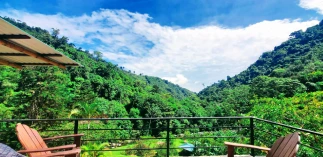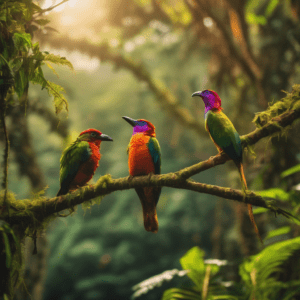Costa Rica is home to extraordinary biodiversity, where lush jungles, coral reefs, and mountain ranges support countless species found nowhere else. The country’s commitment to sustainable tourism principles has transformed the way people travel—turning visitors into contributors to conservation. By aligning tourism with ecological responsibility, Costa Rica has become a living sanctuary where wildlife protection thrives alongside economic development.
The Fragile Web of Biodiversity
Few nations boast such ecological richness packed into a small territory. Costa Rica shelters nearly 5% of Earth’s species across a mosaic of ecosystems—rainforests, mangroves, cloud forests, and volcanic landscapes. Yet, this abundance faces growing threats from deforestation, climate change, and illegal hunting.
Endangered species such as jaguars, sea turtles, and scarlet macaws symbolize both the beauty and fragility of these habitats. The loss of one affects many others in a delicate ecological chain. Tourism, when managed ethically, has become one of the most powerful tools to reverse that decline.
How Tourism Became a Force for Protection?
Decades ago, Costa Rica faced rapid deforestation driven by agriculture and logging. The shift toward sustainable tourism reshaped the country’s future. Instead of exploiting resources, it invested in preserving them—understanding that thriving ecosystems attract travelers seeking authentic, responsible experiences.
This transition redirected the national economy. Protected parks and wildlife refuges became the centerpiece of tourism, generating revenue that funds conservation programs, research initiatives, and local employment. Every entrance fee, guided tour, and eco-lodge stay contributes to sustaining the very landscapes that make Costa Rica remarkable.
Endangered Species That Define Costa Rica’s Natural Heritage
Each endangered species in Costa Rica tells a story of resilience and interconnection. The efforts to protect them reveal how deeply conservation and tourism intertwine.
1. The Majestic Jaguar
Once roaming freely across Central America, jaguars now face habitat fragmentation and poaching. Costa Rica’s rainforests remain one of their few strongholds.
Tourism has helped create biological corridors—protected routes linking fragmented habitats. Visitors participating in jungle treks indirectly support these efforts, as park fees fund tracking projects and camera-trap monitoring. The presence of eco-tourists also discourages illegal hunting through constant human observation.
2. Sea Turtles of the Caribbean and Pacific Coasts
Costa Rica’s beaches are essential nesting grounds for several sea turtle species, including leatherback, green, and hawksbill turtles. These ancient mariners face threats from coastal development and the poaching of eggs.
Tourism has turned once-exploited beaches into zones of protection. Night tours, led by certified local guides, regulate visitor behavior while funding nest monitoring and hatchling releases. Visitors witness a rare natural event while becoming part of its preservation.
Key conservation measures supported by tourism include:
- Controlled beach access to minimize disturbance
- Sponsorship of hatchling release programs
- Community-based turtle patrols funded by ecotourism revenue
- Educational workshops for residents and visitors alike
3. Scarlet Macaws and the Restoration of the Forest Canopy
The scarlet macaw, with its radiant plumage, is an icon of Costa Rica’s biodiversity. Once near extinction due to habitat loss and illegal pet trade, these birds are making a comeback.
Tourist interest in birdwatching has played a crucial role in their recovery. Ecotourism initiatives have funded reforestation with native trees that macaws rely on for nesting and feeding. Travelers who visit birding sanctuaries or stay in eco-lodges contribute directly to these restoration projects.
4. The Baird’s Tapir – The Gentle Guardian of the Forest
Known as the “gardener of the forest,” the Baird’s tapir is vital for seed dispersal. Sadly, it’s one of the most endangered large mammals in Central America. Its shy nature and slow reproduction make its survival challenging.
Responsible tourism in remote regions such as the Osa Peninsula has brought attention and funding to tapir conservation. Local guides, often trained through tourism programs, collect valuable data that helps researchers track population trends. Eco-conscious travelers indirectly sponsor habitat protection through their visits.
5. The Resplendent Quetzal – Jewel of the Cloud Forests
The resplendent quetzal’s shimmering feathers have made it a symbol of Costa Rica’s highlands. However, deforestation and climate change threaten its delicate cloud forest habitat.
Sustainable tourism has provided the financial means to maintain these forests. Birdwatchers traveling to the misty mountains create a steady income for local guides, lodges, and conservation programs. Trails are designed to limit erosion and preserve nesting trees. Every sighting becomes both an economic and ecological victory.
The Role of Protected Areas
Costa Rica’s decision to dedicate around a quarter of its territory to protected zones has been transformative. National parks, reserves, and wildlife refuges not only preserve habitats but also serve as economic engines through regulated tourism.
These areas operate on a self-sustaining model:
- Entrance fees finance rangers and conservation programs.
- Eco-tourism limits visitor numbers to prevent ecosystem strain.
- Research stations allow collaboration between scientists and guides.
- Local communities receive training and employment as custodians of nature.
Tourism becomes the financial backbone of protection, transforming nature from a resource to be extracted into a treasure to be sustained.
Community-Led Conservation and Tourism
At the heart of Costa Rica’s conservation success lies its people. Many rural communities once dependent on logging or agriculture have transitioned to eco-tourism, finding renewed purpose in protecting wildlife.
Local families manage small lodges, lead hiking tours, or work as wildlife monitors. The income from tourism reduces reliance on destructive practices and reinforces the importance of environmental stewardship.
These communities also participate in education initiatives where both residents and travelers learn about sustainable living—recycling, reforestation, and responsible waste management. The result is a shared sense of responsibility where conservation benefits everyone.
The Connection Between Ecotourism and Research
Research and tourism in Costa Rica operate hand in hand. Tourists provide the funding that allows scientists to conduct long-term monitoring of endangered species. Some programs invite visitors to join citizen science projects—counting turtles, photographing jaguars, or recording bird sightings.
This collaboration creates a bridge between curiosity and conservation. Instead of merely observing nature, travelers actively contribute to its protection. The data collected through these programs helps refine national conservation strategies and international wildlife protection policies.
Challenges Facing Wildlife Conservation
Despite its achievements, Costa Rica’s ecosystems remain under pressure. Urbanization, agricultural expansion, and illegal wildlife trade continue to threaten endangered species. Climate change further complicates migration patterns and food availability.
Tourism, if unmanaged, can also cause harm. Excessive visitation may disturb nesting sites or stress animals. That’s why Costa Rica enforces strict guidelines—visitor limits, waste regulations, and sustainability certifications for tourism operators. Balancing tourism’s economic benefits with ecological preservation remains a delicate yet vital mission.
Education and Awareness Through Tourism
Education forms a cornerstone of Costa Rica’s approach to conservation. Guided tours, interpretive trails, and wildlife education centers provide visitors with deep ecological insight. Tourists gain awareness of the impact their choices make—reducing plastic use, respecting wildlife boundaries, and supporting eco-certified businesses.
The experience often inspires lasting behavior change. Many travelers return home with a heightened sense of environmental responsibility, becoming advocates for sustainable practices globally. In this way, the impact of tourism extends far beyond Costa Rica’s borders.
Marine Conservation and Ocean Tourism
Costa Rica’s coastal ecosystems face threats similar to its terrestrial ones—overfishing, coral bleaching, and pollution. Tourism has again become a catalyst for protection.
Through marine tours, diving programs, and sustainable fishing partnerships, visitors help fund coral restoration and mangrove rehabilitation. Certified dive operations follow strict no-touch policies, ensuring minimal interference with marine habitats.
Some marine areas benefit from “volunteer tourism,” where travelers assist with data collection, underwater cleanups, or species identification. These experiences transform passive visitors into active conservation partners.
Ecological Corridors: Linking Habitats Through Tourism
One of Costa Rica’s most significant conservation innovations is the creation of biological corridors—vast stretches of land connecting isolated habitats. These corridors allow species like jaguars and tapirs to roam safely between territories, ensuring genetic diversity.
Tourism plays a vital role in sustaining these corridors. Eco-lodges, research centers, and community reserves within them provide jobs and incentives for locals to protect, rather than clear, the land. Travelers staying in these areas help maintain a continuous network of life across the country.
Success Stories: When Conservation Meets Tourism
Costa Rica’s model offers tangible examples of how tourism safeguards endangered species:
- Leatherback turtle populations have stabilized in some regions due to protected nesting programs supported by tourism revenue.
- Scarlet macaws are once again thriving along the Pacific coast thanks to habitat restoration funded by ecotourism.
- Jaguar sightings in monitored areas have increased as eco-tourists indirectly deter poachers through their presence.
- Reforestation projects supported by tourism have reconnected fragmented habitats, expanding safe zones for countless species.
These victories show that ethical tourism doesn’t just sustain economies—it restores ecosystems.
Responsible Travel Practices That Make a Difference
Visitors have immense power to shape the future of conservation. Simple, conscious decisions amplify the positive impact of tourism.
Ways travelers can support endangered species protection include:
- Choosing eco-certified accommodations and tour operators
- Avoiding single-use plastics during trips
- Staying on designated trails to prevent habitat damage
- Respecting wildlife by keeping a safe distance
- Supporting community-led conservation projects
- Participating in volunteer or citizen science programs
Each responsible action strengthens the link between tourism and preservation, reinforcing Costa Rica’s environmental legacy.
The Role of Education for Future Generations
Costa Rica’s long-term success depends on the next generation. Environmental education begins early in schools, teaching children about biodiversity, recycling, and conservation. Tourism programs often collaborate with schools to involve students in local projects—replanting trees, monitoring birds, or cleaning beaches.
Visitors witnessing these initiatives become inspired by how deeply conservation is woven into daily life. It’s not merely policy—it’s culture.
Technology and Conservation Synergy
Technological innovation enhances Costa Rica’s ability to protect endangered species. Drones monitor remote rainforests, motion sensors record animal activity, and GPS tracking helps scientists map migration routes.
Tourism supports these technologies through funding and data contribution. Digital storytelling platforms allow visitors to share conservation stories worldwide, spreading awareness and inspiring collective responsibility.
The Economic Value of Living Wildlife
Costa Rica’s economy demonstrates that wildlife is worth far more alive than exploited. A single jaguar or nesting turtle can generate more income through ecotourism over its lifetime than through illegal trade. This realization has reshaped local attitudes toward conservation, transforming wildlife from a resource into a long-term investment in sustainability.
Communities see direct benefits—jobs, education, and improved infrastructure—arising from tourism linked to conservation success. This shared prosperity strengthens national commitment to protecting endangered species.
The Emotional Connection Between Humans and Wildlife
Beyond economics and policy lies something more profound—the emotional connection visitors feel when encountering wildlife in its natural habitat. Watching a sea turtle hatchling crawl toward the ocean or hearing a quetzal’s call at dawn evokes humility and responsibility.
These experiences reshape perspectives, reminding travelers that humanity is part of the same fragile ecosystem. It’s this emotional bond that fuels continued global support for conservation in Costa Rica.
A Model for the Future
Costa Rica’s balance between tourism and conservation has become a model for sustainable development. The nation’s approach demonstrates that prosperity and protection can coexist, and that tourism, when guided by ethics, can be a force for renewal.
Its example shows that conservation isn’t about isolation—it’s about participation. Every traveler, community, and policy contributes to a shared vision where nature thrives alongside human progress.
Conclusion
Costa Rica’s story of endangered species and tourism is one of transformation—from exploitation to guardianship. Through a shared commitment to sustainability, this small nation has proven that protecting life brings lasting rewards.
Each traveler who walks its rainforests, swims its coasts, or listens to its wild symphonies becomes part of that story. Costa Rica reminds the world that when tourism nurtures rather than consumes, every journey becomes an act of preservation.







